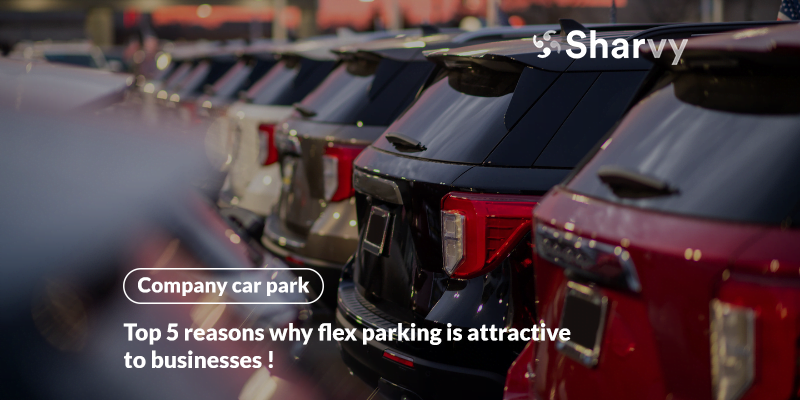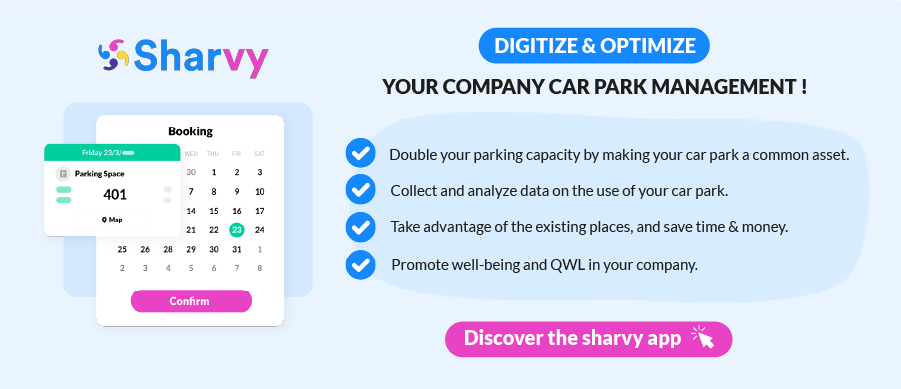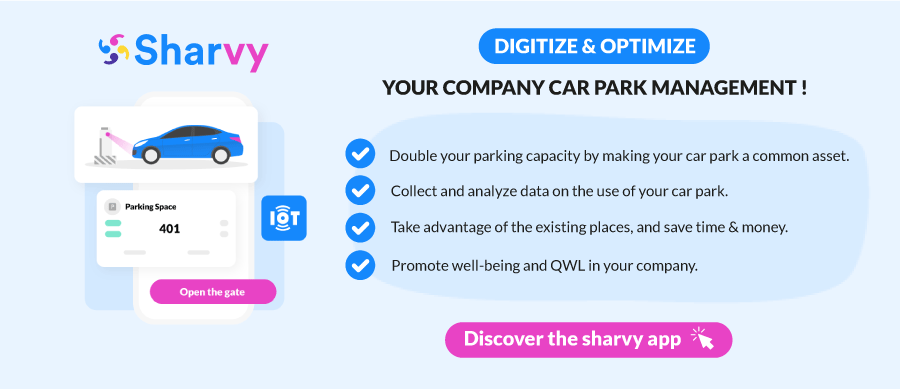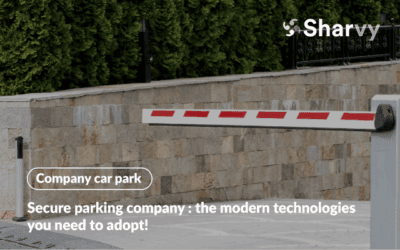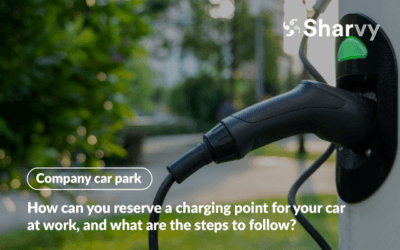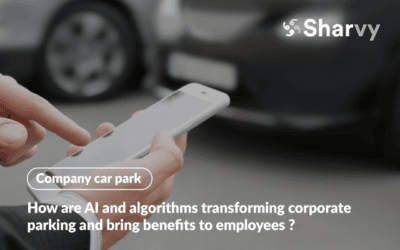A source of revenue as well as injustice, the company car park now raises thorny questions, multiple debates, and numerous paradoxes.
In the past, companies did not have to worry about managing their company car park(s) precisely because the resource of “parking” was abundant and inexpensive. Today, however, this is no longer the case, and employers must take proactive measures to improve their employee’s daily lives.
And let’s not forget : the car still dominates the home-work commute. As a result, the parking needs of all employees (motorists) cannot be met. The reason for this? A shortage of space and the exponential cost of building and renting new car parks force employers to plan their parking needs as precisely as possible. As a result, on peak days, car parks need more spaces to cope with user demand.
The solution? Flex parking is an innovative concept that has won over businesses in recent years by increasing the number of parking spaces at zero marginal cost. Find out more in this article.
From “classic” car parks to flex parking : definitions, issues and prospects.
Flex parking means sharing the parking spaces allocated to a company with all its employees. As a result, parking becomes collaborative and open to all company members.
Ultimately, the idea behind flex parking is as follows : today, with the resurgence of teleworking and new paradigms in the world of work, employee travel is becoming more episodic, and the allocation of company parking spaces is becoming more complex.
As a result, a growing number of named spaces are unoccupied every day for various reasons (business travel, teleworking, days off, etc). However, these parking spaces cannot be used by other employees, as they are reserved spaces!
As a result, the car park is complete (even if it’s not the reality), which can be annoying and frustrating for many employees, who waste a considerable amount of time (around twenty minutes on average) each week looking for parking close to their place of work.
Flex parking is a popular solution to these problems. The reason is that to work, a parking management solution usually accompanies it. This not only ensures that parking spaces are shared equitably but also provides automated allocation of parking spaces, simplified incident management, optimal and unrestricted access control, and, above all, optimized car park occupancy.
So, in this age of individualism, flex parking is a way of reversing that trend and putting all employees on an equal footing. The Sharvy application can (rightly) be your right-hand man in this process!
But who is flex parking for ?
Flex parking is aimed at all public and private companies, local authorities, and universities that want to :
- Reduce/avoid the costs of following their car park(s).
- Make it easier for their employees to park and improve their QWL.
- Facilitating change management during the company relocation.
- Manage their parking policy effectively.
The flex parking also stands out as an ideal solution for efficiently managing parking areas that are often underused or poorly optimized. By enabling better allocation of available spaces, this approach reduces the frustrations of users looking for a place to park. Moreover, by integrating parking management technologies, companies can not only maximize the use of existing spaces but also avoid the costs associated with expanding or creating new parking spaces.
Why is flex parking increasingly attractive to businesses ? Top 5 reasons!
1. A company relocation & a response to new constraints.
Whether it’s to refocus their activities, benefit from lower rents, move closer to their core business, take advantage of the emergence of new industrial countries, or breathe new life into their business and reinvest more strategically following the massive and uninhibited adoption of teleworking, many companies are choosing to relocate.
And while they gain on many fronts, they (often) lose out on parking. Let’s take an example: while the company’s head office used to have around a hundred parking spaces, the new head office only has about fifty for 200 employees.
As a result, parking pressure has increased following the move.
Faced with these new challenges, many companies turn to flex parking when moving their headquarters. This is an opportunity for them to “multiply” their car park(s) and play with the different parking needs, depending on the type of user.
By pooling their parking spaces thanks to flex parking, they are no longer obliged to have an opening for each employee. They can offer access to the car park to a more significant number of employees, significantly improving well-being at work.
2. A (often unsuspected) financial gain for companies.
By making the most of existing facilities and reallocating available space within the car park to avoid having to finance new ones, flex parking can offer companies a significant financial advantage!
At the same time, by digitalizing and dynamizing its management via a dedicated application, it can gain up to 30% more space. They could then consider canceling their rental contracts for spaces in the neighboring car park(s), which have become unnecessary, and generate immediate savings : from $1,500 to $2,000 per year per parking space.
On this point, Sophie VOLLAND, Head of General Services for the Atlantic Group, emphasizes that investing in a Parking Management solution offers substantial financial benefits for the company. She details us : “Renting parking spaces costs the company $153,000 a year. Thanks to flex parking, the potential savings can be as much as $38,000 a year, which is a far cry from the annual cost of the Sharvy solution.
If you’re curious to find out more, take a look at our case study by clicking here, and go a step further by downloading our White Paper on optimizing your parking budget.
3. Optimization of car park size and occupancy thanks to the flex parking.
Even today, only some companies have real, objective data on using their car parks. This lack of statistics, combined with unsuccessful car park management, partly explains the saturation of the car park and, conversely, its under-utilization.
Although awareness of this issue among companies is still deficient, the subject of ‘parking’ is becoming an increasingly important part of their strategic decisions. They now want to take advantage of flex parking and the digitalization it brings to improve the management of their car park(s).
By taking the plunge into flex parking, companies can collect, interpret, and track a wide range of data (car park occupancy and use statistics, activity history, incoming and outgoing traffic, etc.), enabling them to make the right management decisions and improve the parking experience for users.
4. An innovative solution for shared charging points.
Now, with changes in regulations and practices driving the transition to all-electricity, property companies, developers and co-owners are already looking to position themselves on the road to (future) compliance with environmental regulations.
By opting for flex parking and, of course, using a dedicated solution like Sharvy, companies get a genuine reservation interface to guarantee access to electric recharging for all their employees.
Day-to-day operation is effortless. Users make a parking space reservation request from Sharvy. They specify whether they want a parking space equipped with a charging point. If so, they will either be allocated a specific space with a space number (e.g., space no. 405), or they will be given a free space.
On the day, they drive to the reserved space (and find their way using a dynamic map available on the app if unfamiliar with the car park). Once there, they plug in their vehicle and start charging from the app. Sharvy immediately detects the car and indicates the charging power and the energy set. Once charging is complete, it is automatically interrupted.
Note that for office buildings, the vehicles will be stationary for several hours : a power of 7.4 kW is more than sufficient. This gives a range of 30 to 40 km per hour of recharging.
By doing so, companies are deploying an efficient service of shared electric charging points and improving the day-to-day lives of their employees. At the same time, they are promoting low-carbon mobility and improving their CSR policy.
5. Flex parking is a solution for simplifying the management of access authorizations.
There’s no doubt about it : in terms of logistical constraints, flex parking is an opportunity for companies to simplify and streamline the access management to the company car park.
Previously, the company had RFID card and badge readers to filter, control, and authorize access to the company car park, but this management took time and effort. Not only do you have to collect the request for access to the car park, create a badge and/or RFID card, assign a user to it, set up the parameters in the HR management software, and then send it to the employee.
At the same time, and over the longer term, you have to deal with losses, ensure that the car park barrier opens if the badge is forgotten, remember to recover the badge at the end of the employee’s contract and make it anonymous, etc. All these factors make this task a cumbersome one with little added value. All of these factors make this a time-consuming task with little added value.
For companies looking for a new boost, flex parking is an opportunity to modernize car park access management, for example, by opting for a number plate recognition camera. When a vehicle authorized to access the car park approaches, the security barrier opens automatically. As a result, users don’t have to waste time looking for their badges, and the parking experience is improved.
While flex parking has much to offer companies, are there any drawbacks?
1. An initial investment is required.
As a source of new choices, flex parking must now become a key component of the company’s various policies : HR in particular, but also purchasing and CSR.
However, integrating the technologies involved in flex parking requires an initial investment.
Installing various sensors, cameras, and communications infrastructure can represent a considerable financial investment. Small and medium-sized businesses sometimes need help to justify these costs, especially if they have budget constraints. So, even if the costs are amortized over the long term, you still need to be aware of them!
2. Resistance to change needs to be supported.
There’s no doubt about it : introducing a flex parking solution involves a period of adjustment. Employees responsible for managing the system, as well as users, will have to familiarise themselves with this new solution. This introductory stage MUST lead to a gradual learning phase!
However, bear in mind that when this change is announced (and even if it’s a positive one), your employees may react in ways that are often unexpected.
On the one hand, there may be a degree of inertia on the part of employees. In other words, employees don’t protest, but they don’t play along either. In short, there needs to be more reaction to change.
On the other hand, when change imposes itself on employees, and they feel there is no other recourse, you may observe revolts and sabotage on the part of the worst performers. Some may resort to manipulation and stratagems to compromise the project’s success.
As a result, resistance to change can have very different causes and ways of expressing themselves depending on the individual employee, which is why it is so important to provide individualized responses and solutions.
3. A time for the configuration of the car park.
It should be noted that such a solution can be configured according to the company’s needs. As a result, the flex parking administrator must first take the time to configure the chosen solution.
It must therefore recreate the company’s car park “virtually”. This means drawing up a dynamic map of the car park, listing the number of spaces and their types. It must then define the priority rules and specific management features. For example, they may allocate spaces to employees (as holders) according to pre-defined criteria (distance from home to work, home poorly served by public transport, children to be taken to and from work every day, any medical constraints, etc.). The user profiles are then imported and created.
As a result, this process is relatively lengthy, requiring time and attention to create correctly. However, some solutions, such as Sharvy, offer administrators the option of transmitting only the car park plans and communicating the desired management specifications. So, if the flex parking needs to be set up quickly, this service saves the administrator a considerable amount of time. So, it’s worth taking this into account when choosing a solution.
Generally speaking, the time to deploy a flex car park solution varies according to the space profile to be created (technical specifications, installation of access control equipment, specific developments, etc). In most cases, you should allow at least 3 to 4 weeks.
In conclusion
Company car parks are, in a nutshell, dormant potential. By being aware of its added value and of the financial manna that lies beneath its feet, companies can achieve great things.
For employees, it is the entry point to their working environment. For visitors, it is often their first contact with the company they are visiting. So it’s vital to tackle the issue of company car park management head-on, to offer a positive parking experience to all users.
Ultimately, while flex parking is winning over more and more companies with the advantages outlined above, you should also bear in mind that it significantly improves the day-to-day lives and well-being of your employees. The reason is apparent : parking in city centers has become a living hell. Your employees are anxious not to find a parking space and, above all, they waste a considerable amount of time looking for one. At the same time, they may be subject to damage to their vehicles : vandalism, scratches, theft, and many other mishaps, not to mention that they add to traffic congestion and cause unnecessary pollution.
For your employees and your company, flex parking is the perfect way to unlock the full potential of your car park.
A question? Check the following FAQ!
To what extent does flex parking improve a company's CSR policy?
On the one hand, flex parking allows companies to take advantage of existing facilities. As a result, companies no longer need to extend their car park(s) and create new parking spaces. This avoids costly building work, limits soil sealing, and preserves natural ecosystems.
On the other hand, flex parking allows companies to establish a well-thought-out and fair “Parking Management” strategy. As a result, they encourage rotation in the use of parking spaces. As a result, car park holders are less reluctant to use public transport and/or favor soft mobility (carpooling, cycling, and NVEI). And all without losing the use of their parking space, which encourages multimodality within the company car park.
Does flex parking improve fairness within companies?
The notion of fairness is very important within companies. It is an essential lever for creating and maintaining a good working climate. It gives employees greater satisfaction and improves their well-being.
However, in many companies, this notion of fairness needs to be considered. Employees may be looking for “fairness”, which, unfortunately, can lead to several situations: conflict, frustration, dissatisfaction, demotivation, and so on.
If the lack of parking is already a source of frustration and conflict within your company, flex parking may be a good idea. In particular, it offers practical and equitable sharing of parking spaces without you having to lift a finger! What’s more, by digitizing your practices, you get a real-time overview of the occupation and use of your car park while gathering a range of data to help you make the right management decisions.
In this way, you resolve recurring complaints about its management and project an image of a company that cares about the well-being of its employees.
What are the specific challenges of implementing flex parking in businesses, and how can they be overcome?
Flex parking offers numerous advantages, but its implementation can encounter specific challenges, particularly in terms of change management and employee acceptance. Challenges often include resistance to change from employees accustomed to having an assigned parking spot and technical challenges related to the installation of intelligent parking management systems. To overcome these obstacles, it is crucial to actively engage employees from the start of the project, clearly explaining the benefits of flex parking not only for the company but also for them in terms of stress reduction and improved access to parking. In parallel, choosing proven technological solutions and providing adequate training on the use of new systems can facilitate a smooth transition to flex parking.
Why is flex parking becoming an essential parking solution for businesses?
Flex parking is increasingly popular among businesses as it offers a versatile solution tailored to the varied needs of employees. By providing well-located underground and surface car parks, it allows staff to park easily—whether for short-term or long-term periods. Paid parking is often managed via pay-and-display machines, ensuring efficient space management while offering different parking zones, such as blue or green zones.
Flex parking can also accommodate people with reduced mobility (PRMs), with clearly marked reserved spaces. For residents or those with subscriptions, parking permits offer added flexibility, even on public holidays. Access to public and underground car parks further increases availability, reducing stress linked to on-street parking and improving accessibility for pedestrians.
Ultimately, flex parking enhances the user experience with adaptable solutions for all, including those seeking free parking or designated disabled spaces.
Want to learn more? Check out our latest articles!
Secure parking company : modern technologies you need to adopt!
How do you secure parking company? What modern technologies should you adopt? What are the benefits? The answers in this article!
How do you reserve a charging point for your car at work?
How do I recharge my car at work? Do I need to reserve a charging point? What solutions are available? Here are the answers!
How are AI & algorithms transforming corporate parking?
How are AI & algorithms redefining corporate parking? What are the benefits for your company & your employees? Focus!
Subscribe to our newsletter!
Resources
Contact us
+44 117 463 6990

